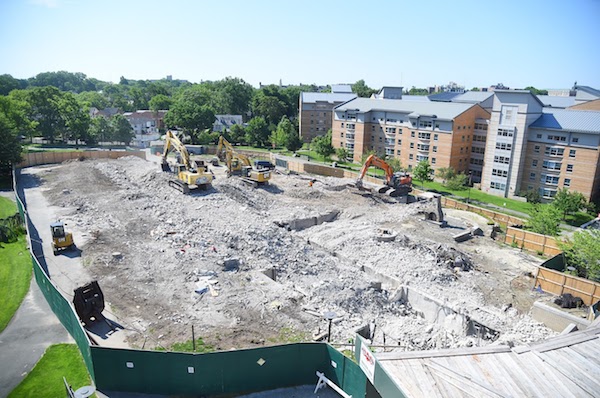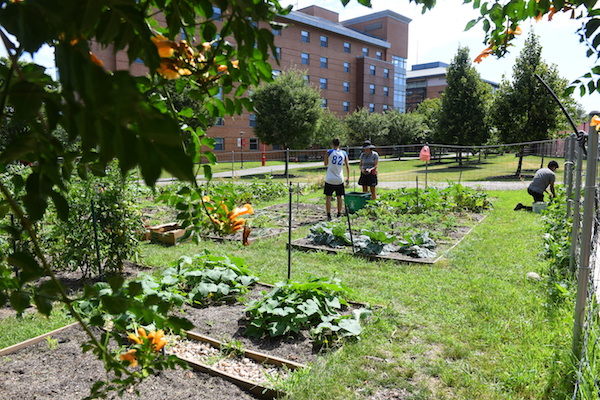
HILLCREST — The grass is greener at St. John’s University. Then again, so is most everything else.
The 152-year-old university has spent the past few years working toward becoming a greener, more environmentally friendly campus, and those efforts are gaining national attention.
The Princeton Review named St. John’s University one of the top 50 eco-friendly universities in the U.S. The findings, which are based on a survey of students and college administrators from 713 colleges and universities across the country, are published in The Princeton Review Guide to Green Colleges 2023 Edition. There are a total of 455 schools in the guide, with each ranked on a scale of 60 to 99. St. John’s University earned a ranking of 97 out of 99.
At No. 39 in the guide, St. John’s University is the only school in New York City to crack the top 50.
The school was cited for its comprehensive approach to reducing its carbon footprint with steps that include: installing solar panels, upgrading boilers, retrofitting pipes, redesigning classrooms and other initiatives that are expected to save the school 300,000 kilowatt hours of energy each year.
Julianna LoMonte, student government secretary, said there is another feature of campus life that is appreciated by environmentally aware students. “Our university has gone paperless. There are no printed pamphlets or printed materials of any kind. Everything is posted online,” she said.
“We’re very proud of that here at St. John’s,” LoMonte, a senior, added.
Under the university’s Climate Action Plan, the school is on a path to reduce its carbon emissions by 50% by the year 2030, officials said.
In addition, the university, which has an enrollment of 20,000 students, employs a full-time campus sustainability officer and offers graduate students the chance to earn a Master’s Degree in Sustainability.
“In addition to its excellent academic programs, St. John’s demonstrates an exemplary commitment to sustainability and to greener practices,” Rob Franek, editor-in-chief of the Princeton Review guide, said in a statement.
Father Brian Shanley O.P., the university’s president, said a greener campus is not only part of the mission of St. John’s, but it is also in keeping with Pope Francis’s call — in his Laudato Si encyclical issued in 2015 — for Catholics to respect the environment.
“At. St. John’s University, we have embraced and responded to the call of Laudato Si which asks each of us to more fully care for others and care for God’s creation,” he said.
St. John’s is in this for the long haul, according to Father Shanley. “We want all people associated with St. John’s to work to protect God’s creation for future generations, to embrace a lifestyle change for their own good, and to take care of people who are poor and more vulnerable,” he added.

Students, meanwhile, have been taking their own initiative. Nawsin Kamal, a junior who serves as student government speaker, said each of the student organizations on campus has created green goals. The student government, for example, distributes only sustainable-material cups and napkins at its meetings and events.
The Princeton Review acknowledgment will further encourage students to go greener, she said. “There are steps all of us can and should take,” she added.
The designation gives students bragging rights, “I’m not surprised to see us in the top 50. We did put in the work,” Earth Club president Rosanna Jiang said.
“I’m hoping it has a spiraling effect that encourages students to do more,” said Caitie Dupre, sustainability chairperson for the St. John’s chapter of Catholic Relief Services.
Teamwork made it happen, said Thomas Goldsmith, director of environmental and energy conservation. St. John’s “is very much aware that students, faculty and administration all contribute toward this goal,” he added.
Still, there are more steps that could be taken, even bold moves, students said.
Liang, a junior, was impressed during a recent trip to Portugal to see the hotel where she was staying turn off its electricity at night. “I’d like to do something like that here,” she said.
Dupre, a junior, said even something simple — like turning off the light switch when leaving a room — can help. “I’ve seen students leave the lights on. They should be encouraged to be more aware. It doesn’t sound like much but when you multiply it by the number of students, it matters,” she said.
